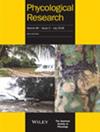Morphology and molecular phylogeny of the marine diatom genus Nagumoea (Bacillariophyceae) from Japan
IF 1
4区 生物学
Q2 MARINE & FRESHWATER BIOLOGY
引用次数: 0
Abstract
The canal‐bearing diatom genus Nagumoea, described based on only morphological evidence, was tentatively assigned to the order Bacillariales, although its phylogenetic position remained unclear. Because three isolates of Nagumoea (SK002, SK024 and SK053) were successfully established from Japanese coasts, we performed their morphological observations and molecular phylogenetic analyses to discuss the phylogeny and taxonomic position of this genus. Strains SK002 and SK024 were identified as Nagumoea africana, whereas SK053 conformed with Nagumoea serrata. There was high interspecific divergence between N. africana and N. serrata in the rbcL sequences (8.03–8.17%), indicating their distinctness. Furthermore, intraspecific variations were detected within N. africana (2.35%) in the rbcL, implying its cryptic diversity. The maximum likelihood and Bayesian phylogenetic trees inferred from the plastid rbcL, psbC and nuclear 18S rDNA genes recovered Nagumoea as monophyletic with strong statistical support and embedded within an unresolved, poorly supported lineage containing Achnanthes, Craspedostauros, Staurotropis and Undatella in the canal‐bearing order Bacillariales (= the family Bacillariaceae). Although the constrained tree based on the monophyly of Nagumoea and the other canal‐bearing clade (Surirellales and Rhopalodiales) was statistically rejected by the topology tests, the phylogenetic position of Nagumoea with other Bacillarialean members remains equivocal. The possession of two plastids positioned fore and aft, observed in the present study, and lack of keel, typical of the Bacillariales, indicate the possibility of Nagumoea being part of the ingroup of the Bacillariales or its closely related outgroup.日本海洋硅藻属(硅藻科)的形态和分子系统发育
仅根据形态学证据描述的带管硅藻属Nagumoea,暂时被归入Bacillarales目,尽管其系统发育位置尚不清楚。由于从日本海岸成功建立了三个名瘤菌分离株(SK002、SK024和SK053),我们对它们进行了形态学观察和分子系统发育分析,以讨论该属的系统发育和分类地位。菌株SK002和SK024被鉴定为非洲名瘤菌,而SK053与锯齿名瘤菌一致。在rbcL序列中,非洲猪笼草和锯齿猪笼草之间存在较高的种间差异(8.03–8.17%),表明它们的差异性。此外,在rbcL中,在非洲猪笼草(2.35%)中检测到种内变异,这意味着其隐蔽的多样性。从质体rbcL、psbC和核18S rDNA基因推断出的最大似然和贝叶斯系统发育树将Nagumoea恢复为单系,具有强大的统计支持,并嵌入到一个未解决的、支持不足的谱系中,该谱系包含Bacillariales目(=Bacillariaceae科)中的Achnanthes、Craspedostauros、Staurotropis和Undatella。尽管基于Nagumoea和其他含管分支(Surirellales和Rhopalodiales)的单系的约束树在拓扑测试中被统计学拒绝,但Nagumoe与其他Bacillaralean成员的系统发育位置仍然模糊不清。在本研究中观察到,拥有两个位于前后的质体,并且缺乏龙骨,这是贝母目的典型特征,这表明Nagumoea可能是贝母目的内群或其密切相关的外群的一部分。
本文章由计算机程序翻译,如有差异,请以英文原文为准。
求助全文
约1分钟内获得全文
求助全文
来源期刊

Phycological Research
生物-海洋与淡水生物学
CiteScore
3.60
自引率
13.30%
发文量
33
审稿时长
>12 weeks
期刊介绍:
Phycological Research is published by the Japanese Society of Phycology and complements the Japanese Journal of Phycology. The Journal publishes international, basic or applied, peer-reviewed research dealing with all aspects of phycology including ecology, taxonomy and phylogeny, evolution, genetics, molecular biology, biochemistry, cell biology, morphology, physiology, new techniques to facilitate the international exchange of results. All articles are peer-reviewed by at least two researchers expert in the filed of the submitted paper. Phycological Research has been credited by the International Association for Plant Taxonomy for the purpose of registration of new non-vascular plant names (including fossils).
 求助内容:
求助内容: 应助结果提醒方式:
应助结果提醒方式:


